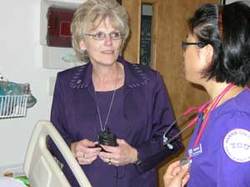As purple as the day is long: a profile on Mary Beth Walker
 |
Fort Worth, TX
4/21/2008
Mary Beth Walker’s first memory of TCU is a small, purple corduroy pillow with a horned frog on it that sat in her crib as a baby. Today, Mary Beth is the Assistant Director for Simulation in Harris College of Nursing and Health Sciences.
Mary Beth is from a long line of TCU legends. Her mother (’48) was one of the few females to receive a degree in Geology during her time; her grandfather founded the physics department; Randolph Clark, one of TCU’s founders, conducted the wedding between her grandfather and grandmother just to name a few of the connections to the university; and Mary Beth graduated from TCU in 1980.
As Assistant Director for Simulation, Mary Beth manages the simulation lab for nursing students. Students begin working in the lab during their second semester of sophomore year in conjunction with clinical internships. The simulation lab is a learning center outside of the classroom for students to gain hands-on experience in a controlled environment. It includes video recording capabilities, two adult simulators, a six-year-old child simulator and a maternity simulator—which actually gives birth.
Until recently not all students have had the opportunity to use the lab during their time as an undergraduate, because the simulation lab is shared by nurse anesthesia students, which makes less time available for nursing students, but this summer the nurse anesthesia students will move to a new location and both labs will expand to allow all students more time in them.
Mary Beth hopes to expand the simulation lab to allow all nursing students to work in it during their time at TCU. Her plans include advancing the video recording capabilities, adding a control room and more simulators to further the believability of the scenarios.
“The more you make simulation life-like and less pretend, the easier it is to suspend disbelief in students,” she says, and the plans for the future of the lab reflect that.
In the past, the simulation lab has been left to the discrepancy of the professor, but Mary Beth hopes to integrate it into the curriculum to make sure each student has substantial time in the lab.
Teachers use the simulation lab as a resource to parallel lessons learned in the classroom. It is up to the teacher to decide when to teach and when to let students apply their knowledge and skills learned in the class, she says.
Simulators allow students to see and respond to the reactions of “patients” in certain scenarios. The simulators act as real patients—they breathe in oxygen, release carbon dioxide, their pupils dilate, and respond to medicine.
To help students further believe the given scenarios, Mary Beth applies makeup and clothes to the simulators. “This takes students out of the class, and into a different world,” she says.
TCU is a substantial part of Mary Beth, and the simulation lab is her way of being a part of both TCU and students’ lives.
“It is a great privilege to be in students lives,” she says. “I am honored to be in such as special place with special people in the nurse education field, and it is amazing to see all that is happening to make it grow.”
In 2004, her son graduated from TCU with a degree in mechanical engineering, and in 2006 her daughter graduated with a degree in speech pathology and will soon complete the master’s program here as well.
Mary Beth is purple through and through, and it shows in the devotion to her work, students and alma mater. She hopes to pass on her love and devotion to her grandchild, who is due this summer. She has already accumulated several TCU things, but she only wishes she could find a corduroy pillow.










